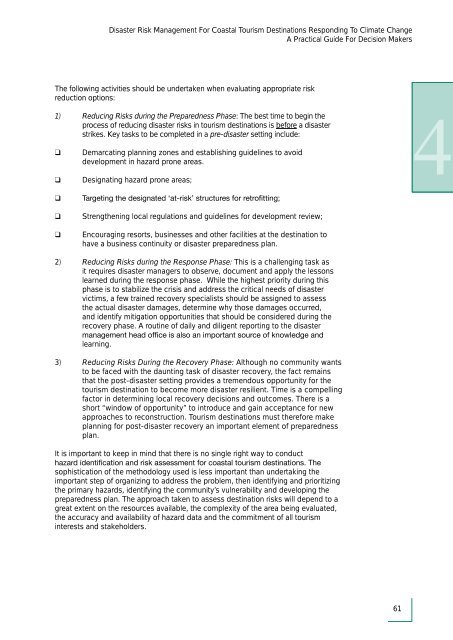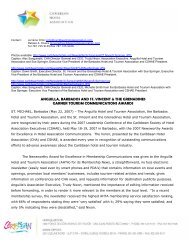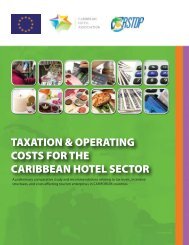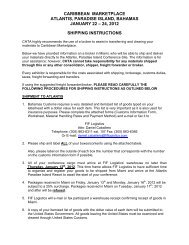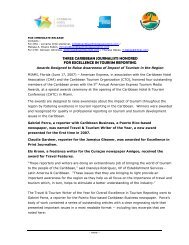Disaster Risk Management for Coastal Tourism - Caribbean Hotel ...
Disaster Risk Management for Coastal Tourism - Caribbean Hotel ...
Disaster Risk Management for Coastal Tourism - Caribbean Hotel ...
Create successful ePaper yourself
Turn your PDF publications into a flip-book with our unique Google optimized e-Paper software.
<strong>Disaster</strong> <strong>Risk</strong> <strong>Management</strong> For <strong>Coastal</strong> <strong>Tourism</strong> Destinations Responding To Climate Change<br />
A Practical Guide For Decision Makers<br />
The following activities should be undertaken when evaluating appropriate risk<br />
reduction options:<br />
1) Reducing <strong>Risk</strong>s during the Preparedness Phase: The best time to begin the<br />
process of reducing disaster risks in tourism destinations is be<strong>for</strong>e a disaster<br />
strikes. Key tasks to be completed in a pre-disaster setting include:<br />
<br />
<br />
Demarcating planning zones and establishing guidelines to avoid<br />
development in hazard prone areas.<br />
Designating hazard prone areas;<br />
4<br />
<br />
<br />
<br />
<br />
Strengthening local regulations and guidelines <strong>for</strong> development review;<br />
Encouraging resorts, businesses and other facilities at the destination to<br />
have a business continuity or disaster preparedness plan.<br />
2) Reducing <strong>Risk</strong>s during the Response Phase: This is a challenging task as<br />
it requires disaster managers to observe, document and apply the lessons<br />
learned during the response phase. While the highest priority during this<br />
phase is to stabilize the crisis and address the critical needs of disaster<br />
victims, a few trained recovery specialists should be assigned to assess<br />
the actual disaster damages, determine why those damages occurred,<br />
and identify mitigation opportunities that should be considered during the<br />
recovery phase. A routine of daily and diligent reporting to the disaster<br />
<br />
learning.<br />
3) Reducing <strong>Risk</strong>s During the Recovery Phase: Although no community wants<br />
to be faced with the daunting task of disaster recovery, the fact remains<br />
that the post-disaster setting provides a tremendous opportunity <strong>for</strong> the<br />
tourism destination to become more disaster resilient. Time is a compelling<br />
factor in determining local recovery decisions and outcomes. There is a<br />
short “window of opportunity” to introduce and gain acceptance <strong>for</strong> new<br />
approaches to reconstruction. <strong>Tourism</strong> destinations must there<strong>for</strong>e make<br />
planning <strong>for</strong> post-disaster recovery an important element of preparedness<br />
plan.<br />
It is important to keep in mind that there is no single right way to conduct<br />
<br />
sophistication of the methodology used is less important than undertaking the<br />
important step of organizing to address the problem, then identifying and prioritizing<br />
the primary hazards, identifying the community’s vulnerability and developing the<br />
preparedness plan. The approach taken to assess destination risks will depend to a<br />
great extent on the resources available, the complexity of the area being evaluated,<br />
the accuracy and availability of hazard data and the commitment of all tourism<br />
interests and stakeholders.<br />
61


